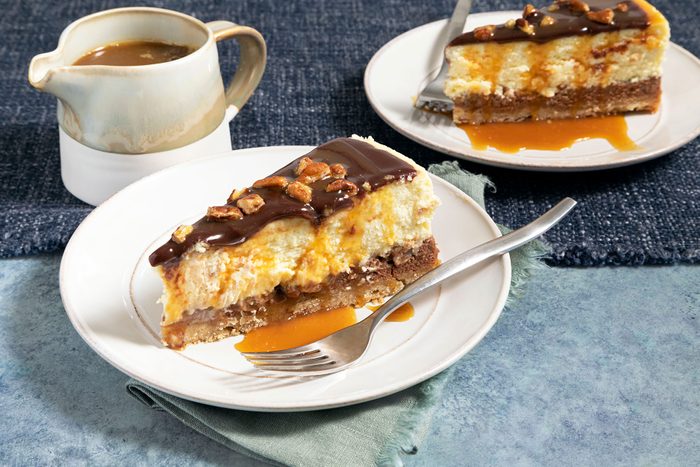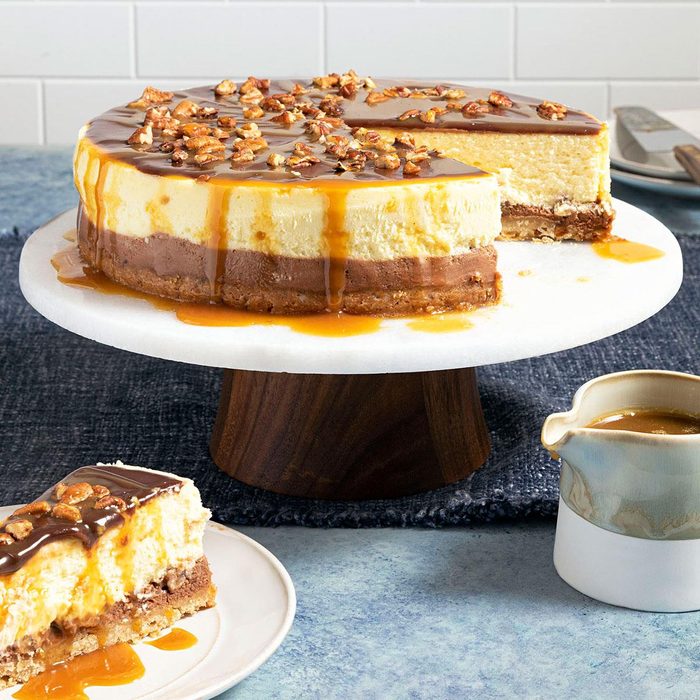When it comes to cheesecake, you have two camps. The straight-forward traditional cheesecake with graham cracker crust and simple, if any, topping. And then you have cheesecake recipes, like this top-rated turtle cheesecake, that really pull out all the stops. It doesn’t matter which side you’re on—you’ll have delicious cheesecake either way!
Turtle cheesecake has something to delight everyone. Cheesecake aficionados will appreciate the smooth, creamy made-from-scratch filling. Anyone who loves decadent chocolate desserts will delight in the rich ganache topping. And fans of sweet-and-savory turtle candies will relish the swirl of caramel and smattering of pecans. Make a layered turtle cheesecake for a special occasion or a big holiday party—everyone will want the recipe.
Ingredients for Turtle Cheesecake
- Cream cheese: Tangy, smooth cream cheese is the foundation of all cheesecakes. Make sure to use the boxed cream cheese; the spreadable cream cheese from the tub is too thin. You may sub in low-fat cream cheese, but non-fat isn’t rich enough for the recipe.
- Pecans: Buttery pecans add a dose of crunch to the cheesecake. For optimal flavor, pecans are added to the crust, filling and topping. We love pecans here, but you can also use walnuts if you prefer.
- Chocolate: Both the cheesecake filling and homemade ganache topping call for milk chocolate chips. Milk chocolate has a mild flavor and melts well. If you prefer, you can replace all or part of the milk chocolate chips with semi-sweet chocolate. Avoid dark chocolate, which doesn’t melt as smoothly and is too bitter.
- Caramel: A swirl of caramel is essential to a true turtle flavor. This recipe calls for caramel ice cream topping for ease, but you could make homemade caramel sauce.
Directions
Step 1: Prepare the pan
Preheat the oven to 325°F. Grease a 9-inch springform pan well. Set it on two doubled-up sheets of heavy-duty foil (about an 18-inch square). Securely wrap the foil around the pan.
Editor’s Tip: Because you bake the cheesecake in a water bath, you want to wrap the outside of the pan well. Plus, it will be your best friend in case of leaks!
Step 2: Make the crust
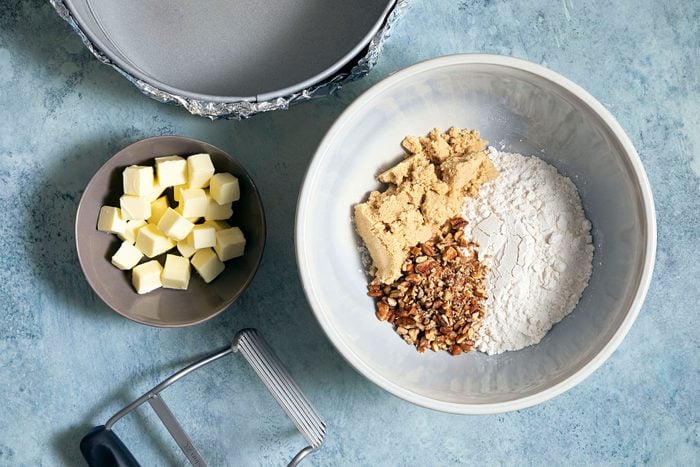
In a small bowl, combine the flour, brown sugar and pecans.
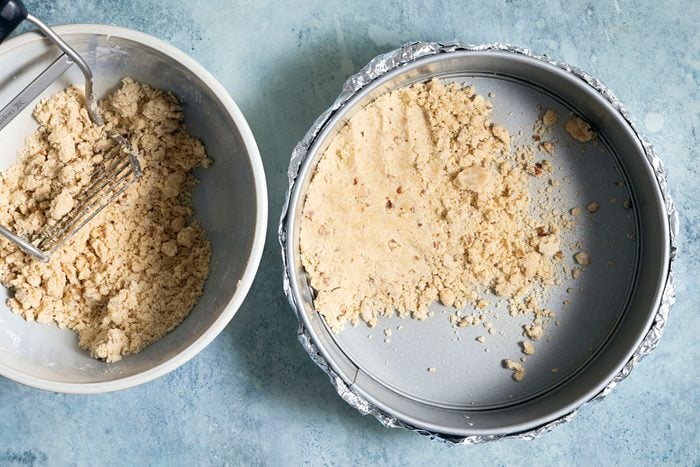
Cut in the butter until crumbly, then press the mixture onto the bottom of the prepared pan. Place the pan on a baking sheet. Bake until set, 12 to 15 minutes. Let it cool on a wire rack.
Editor’s Tip: You can also use your fingertips to rub the butter into the flour mix. You don’t want to overwork the crust; it should just hold together. This ensures a tender crust.
Step 3: Make the filling
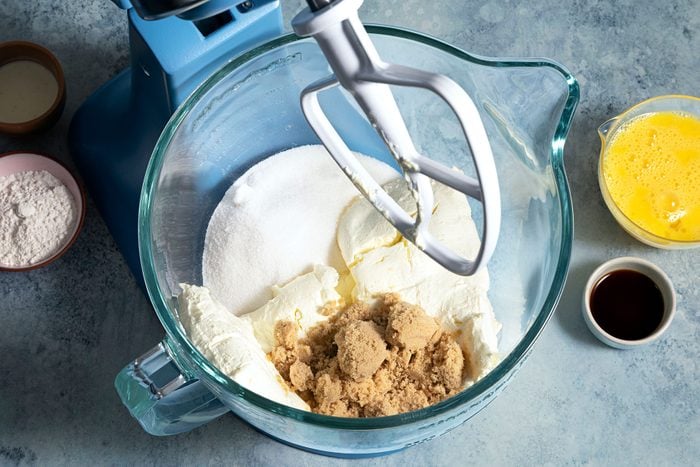
In a large bowl, beat the cream cheese and sugars until smooth.
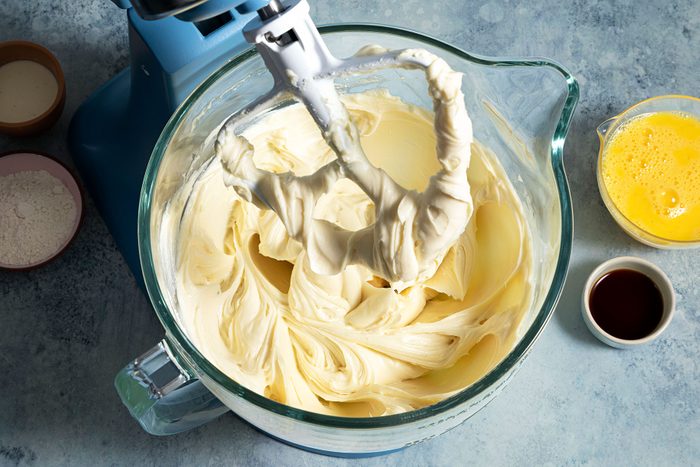
Beat in the 1/4 cup flour, then the cream and vanilla.
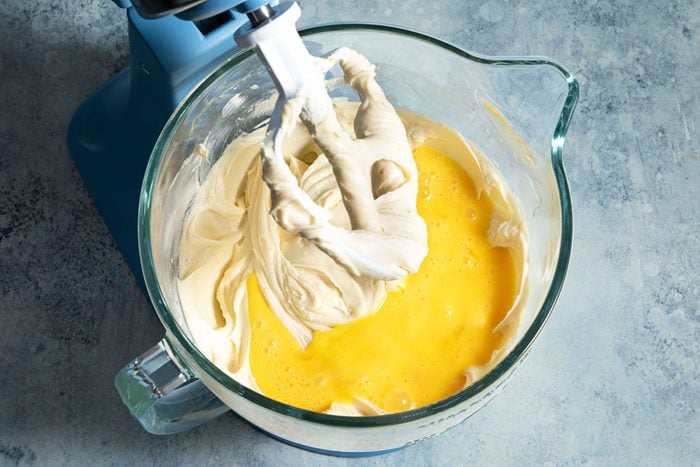
Add the eggs and beat on low speed just until blended.
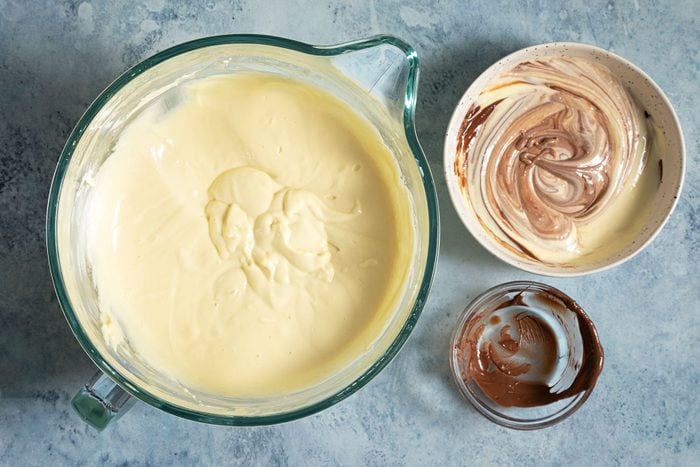
Transfer 1 cup of the batter to a small bowl, and stir in the melted chocolate.
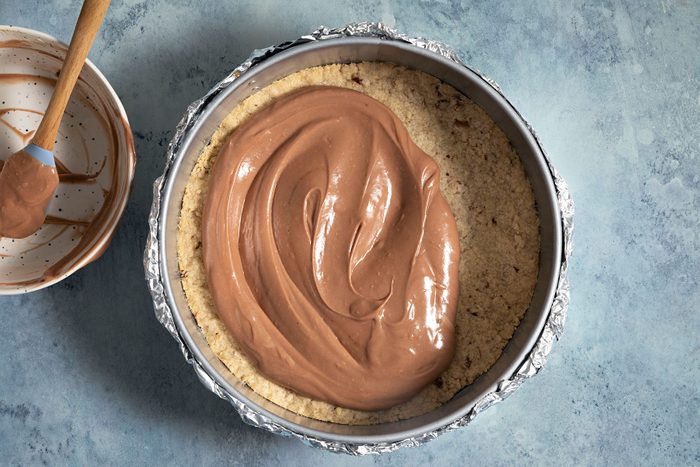
Spread this chocolate-enhanced batter over the cooled crust.
Editor’s Tip: Overbeating is one of the biggest cheesecake mistakes that could result in an excess of air worked into the cheese mix, which could make the whole thing collapse when baking.
Step 4: Layer up the filling
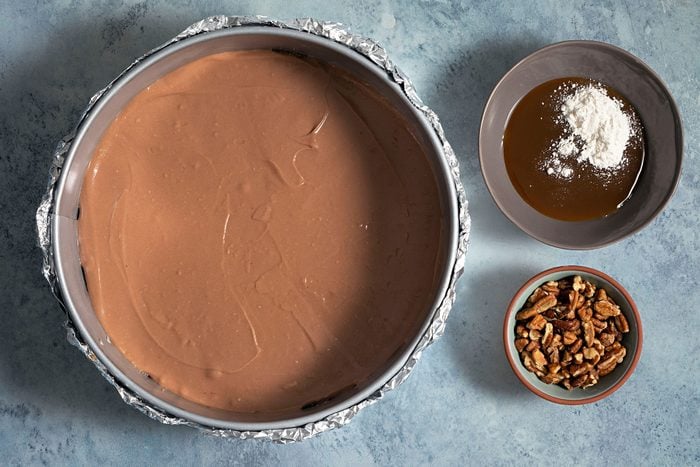
In another bowl, mix the caramel topping with the remaining 1 teaspoon flour. Stir in the pecans.
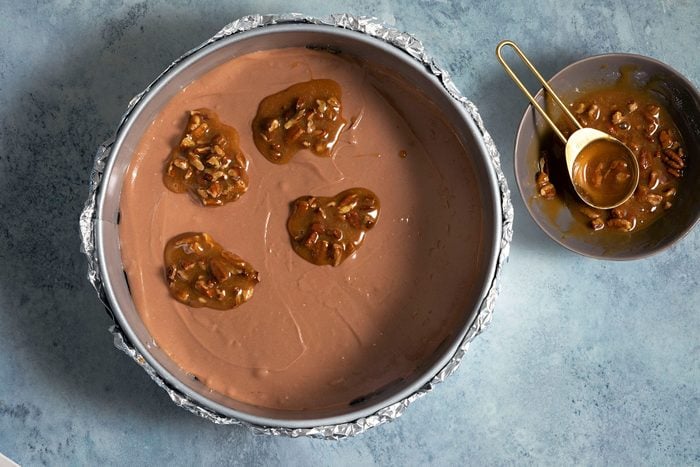
Drop spoonfuls of this mix over the chocolate batter.
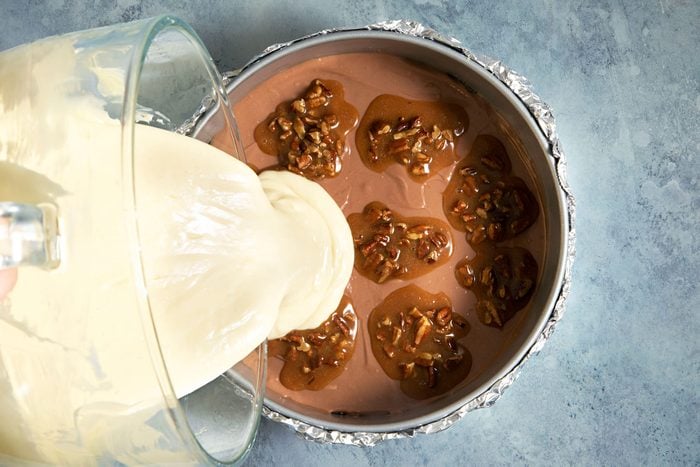
And then top with the remaining batter.
Step 5: Bake
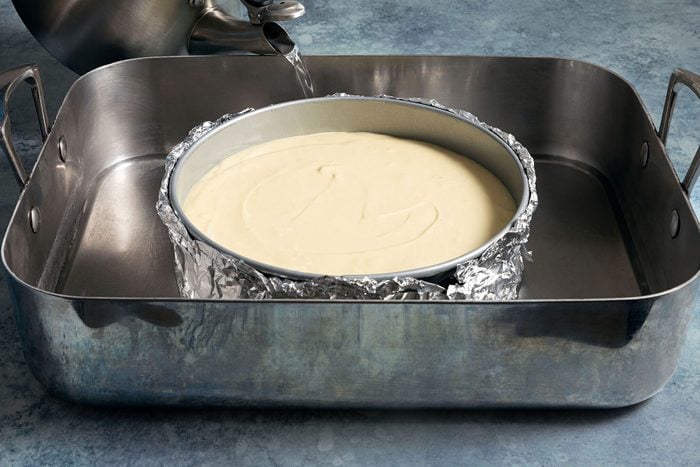
Place the springform pan in a large baking pan. To make a water bath, add an inch of hot water to the larger pan. Bake the cheesecake until the top appears dull in color, about one hour and 15 minutes to one hour and 30 minutes. Remove the springform pan from the water bath and carefully remove the foil.
Editor’s Tip: You’ll know the cheesecake is done when the center is just set with a slight wobble.
Step 6: Chill
Cool the cheesecake on a wire rack for 10 minutes. With a knife tip, loosen the sides from the pan, but do not remove the springform pan. Cool for another hour longer, and then refrigerate overnight.
Editor’s Tip: In general, it’s always best to let a cheesecake set fully before cutting. However, for this recipe, you need it fully chilled to add even more layers!
Step 7: Make the ganache
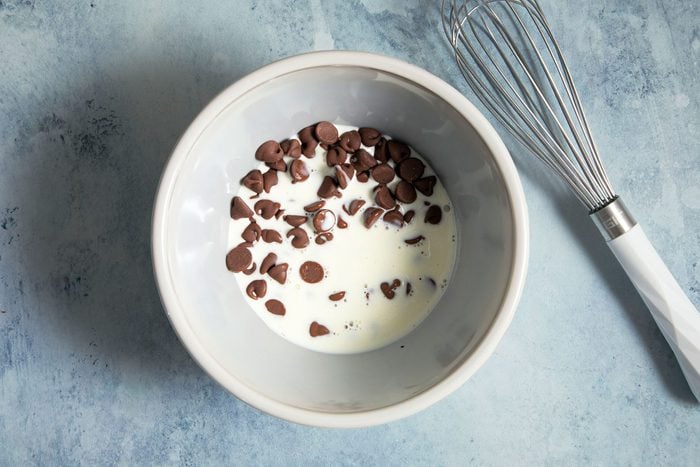
Place the chocolate chips in a small heatproof bowl. In a small saucepan, bring cream just to a boil. Immediately and carefully pour over the chips. Whisk until the chocolate is melted and the mixture smooth. Allow to cool slightly, stirring occasionally.
Editor’s Tip: For the best texture, make this directly before finishing the cheesecake. If you make it in advance, you may refrigerate the ganache overnight and gently reheat it in the microwave, stirring frequently and heating in short bursts. Take care not to overheat the ganache, which can make it grainy.
Step 8: Finish the cheesecake
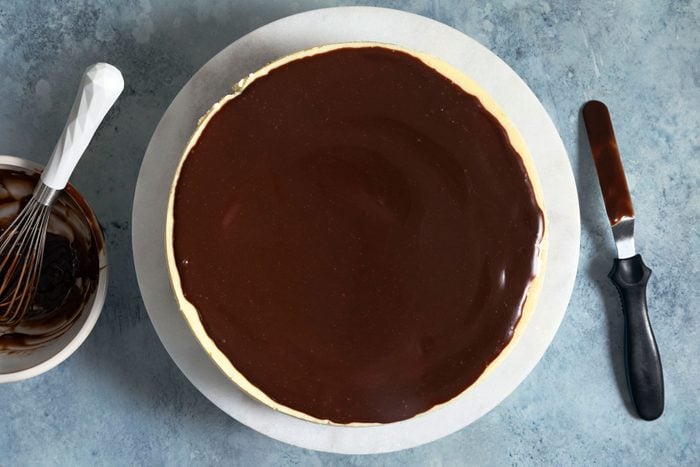
Take the cheesecake out of the fridge. Remove the side of the springform pan. Spread the ganache over the cheesecake and sprinkle with pecans. Refrigerate again until set. Before serving, drizzle with additional caramel topping, if desired.
Recipe Variations
- Try a different crust: Many types of pie crusts taste great with this cheesecake, from a store-bought crust to an easy Oreo cookie crust to a graham cracker crust. Try a gluten-free crust, if you like.
- Add a garnish: Gild the lily by adding even more decorative (and tasty) toppings to the cheesecake. Crumbled cookies, gold leaf or truffles would be extra special (we have lots of easy truffles recipes).
How to Store Turtle Cheesecake
Leftover turtle cheesecake should be kept in the refrigerator, covered, with a cake dome or foil. The cheesecake will keep well for five to seven days, especially if it stays cold. Bringing the entire cake up to room temperature, then re-refrigerating, will make it more prone to spoiling.
How to Freeze Turtle Cheesecake
Here’s the trick: Plain cheesecake freezes very well; decorated cheesecakes don’t freeze as well. To freeze this turtle cheesecake, we suggest preparing the recipe through Step 6, then allowing the baked cheesecake to cool completely before wrapping well in foil and freezing. It will keep well for up to three months in the freezer. Defrost in the refrigerator and finish with the ganache topping in Steps 7 and 8.
Turtle Cheesecake Tips
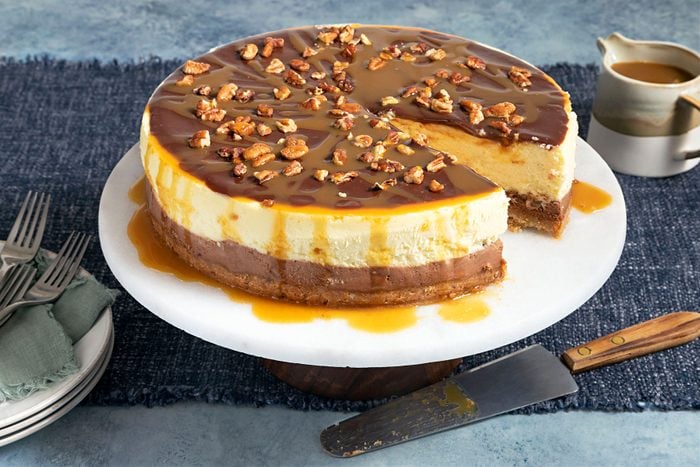
Do you have to bake turtle cheesecake in a water bath?
We recommend baking all kinds of cheesecake in a water bath—we do it even if the recipe doesn’t call for it! The water bath helps to “insulate” delicate bakes like cheesecakes from direct heat, allowing them to bake more evenly, rather than drying out on the sides in the time it takes for the center to cook. Be sure to use hot water when setting up the bath.
How do you prevent cracks in the cheesecake?
Cracked cheesecake is always a bummer (although it will still taste delicious!). To prevent cracks, always grease your pan, even if it’s nonstick. Otherwise, cheesecake may stick to the edges and when the cake contracts during baking, gashes form. Also, avoid overbeating the eggs. That puts extra air in the filling, which can create cracks. Finally, cracks can occur when the top of the cake bakes too quickly. Set the cheesecake on the middle rack of the oven, and drape the top with foil if it looks to be darkening too quickly.
How do you know when the turtle cheesecake is done?
The best cheesecake test is to find “the wobble.” It’s easy: give the edge of the pan a gentle but firm rap with a spoon to see if the cheesecake wobbles. A perfectly baked cake has a slight wiggle, mostly in the center. An underbaked cheesecake will jiggle all over. If a cheesecake is perfectly firm, it’s probably cooked too long.
